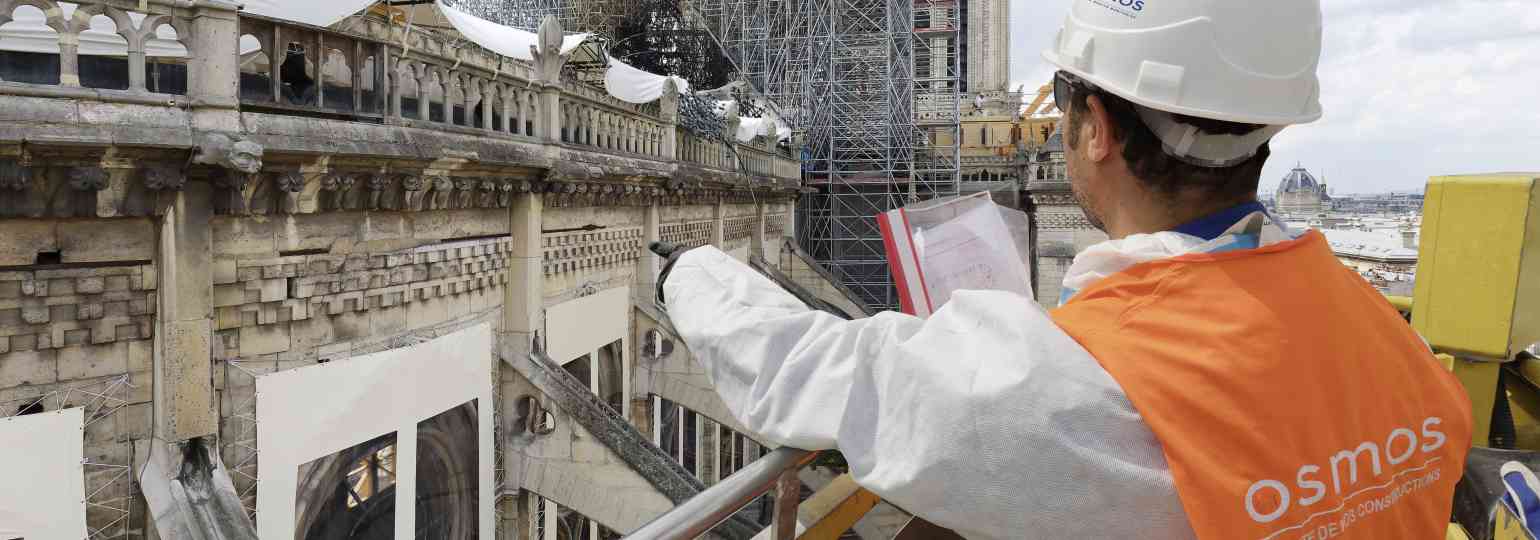
Installation of Optical Strands and inclinometers on the flying buttresses © OSMOS Group SA
OSMOS Group, which monitors many historic monuments, was contacted by ACMH, responsible for the project’s management, and DRAC Ile-de-France, the contracting authority up until the creation of EPRNDP (the public establishment for the conservation and restoration of Notre-Dame Cathedral) on December 1, 2019. They asked OSMOS for its expertise on changes in the structure of the damaged cathedral. Multiple solutions, based on a customized system of more than 140 sensors and mathematical data processing, were implemented for the continuous, real-time monitoring of the building’s sensitive areas. Looking ahead to the cathedral’s restoration phase, OSMOS’s analyses aim to provide advanced technical support to ACMH and the public establishment (now the contracting authority).
On Monday, April 15, 2019, a fire ravaged Notre-Dame Cathedral in Paris, destroying the roof, the framework, the spire and a portion of the vaulting, in particular. Since then, there has been some doubt as to the stability of the building, which was strongly affected by the incident. Within this context of pressing urgency, OSMOS was tasked with placing the weakened parts of the cathedral under continuous monitoring, just one week after the disaster.
Tailored solutions to control structural risks and ensure optimal safety for the project to secure and strengthen Notre-Dame
The OSMOS team had to be responsive and react to the various challenges at hand. In consultation with the contracting authority, multiple OSMOS monitoring systems were defined, based on the client’s questions about the movement of the most sensitive structures (vaulting, flying buttresses, gutter walls and damaged scaffolding). Automated alert systems were also set up to notify the teams working on the site, as well as project management, in the event of the structure’s abnormal behavior. The rollout of OSMOS’s systems secured the worksite and made it possible for the teams to safely launch the building’s reinforcement phase.
OSMOS’s model is based on mastery of the entire value chain, from the identification of needs to data analysis and assessment assistance. In the case of the project to secure Notre-Dame Cathedral, the combination of these different skill sets made it possible to offer a service that was fully in line with the challenges. As a result, the project provided an opportunity to activate all of the different disciplines at OSMOS: from the R&D Department to the Installation Department, by way of the team of engineers who specialize in structural mechanics, but also the Science Department, which is dedicated to the creation of data processing algorithms. To offer the best possible support to the client and expand the teams’ availability, a number of extraordinary measures were also taken, namely including the establishment of on-call duty and on-site watch shifts.
As the project went on, the instrumentation increased in number. OSMOS’s actions on Notre-Dame are ongoing, and the company is also participating in an important stage: monitoring during the disassembly of the damaged scaffolding. Its role consists of monitoring the monument’s stability in real time and verifying the new load distribution across the structures in place. Just as with the sensitive parts of the cathedral, a system of automated alerts was paired with the monitoring set-up installed on the scaffolding. Any significant movement of the metalwork is reported to the on-site teams, project management and OSMOS’s engineers, so as to ensure maximum worker safety before and during the disassembly operations.
From project safety to assessments: When SHM assists a contracting authority with the preservation of ancient heritage
Since August 2020, there has been a gradual shift from the building safety phase toward an assessment phase. The accumulation of data and their processing by dedicated analytical tools have already yielded relevant information about the cathedral’s residual mechanical behavior. The contracting authority and project manager will use those analyses to plan ahead for the restoration of Notre-Dame.
Along those same lines, OSMOS is preparing to implement a new engineering service, involving analyses of the vibrational behavior of the cathedral’s structure after undergoing repeated external strains, including wind and road traffic, but also the ringing of the bells. These assessments will require a specific vibration analysis methodology and the use of a dedicated mathematical algorithm, developed by OSMOS’s Science Department and proven through other applications, namely on high-rise buildings in seismic zones. Equipping Notre-Dame’s belfries and nave with further instrumentation will enable the identification of their specific modes and frequencies of vibration, with the end goal of re-creating the structure’s overall modal deformation. In other words, this will entail characterizing the cathedral’s mechanical behavior when subjected to vibrations. This new stage in the project is a step forward for research into the structural mechanics of ancient heritage sites.
The data and the analytical results will provide a precious history of the state of the building and the progress made on the cathedral’s reconstruction. To ensure this in-depth knowledge of the building is passed on to future generations, OSMOS is sharing all of its project data, analyses, photos and documents with the CNRS (French National Center for Scientific Research). It is a great source of satisfaction to the company to see its efforts put to work in service of research and used as a historical record of Notre-Dame’s restoration project.
